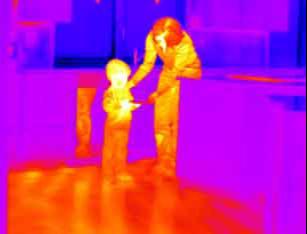Radiant Floor Thermal Comfort
What is it and why is it the most important consideration in a floor heating design.
To fully understand the advantages of radiant panel heating it's necessary to understand thermal comfort.

Floors and cookies are best when warm
Infrared photography shows why radiant is the most comfortable and efficient heat there is
Although most people know when they're comfortable, few of them know why. "Comfort professionals" need to understand what factors affect thermal comfort and how to create an interior environment that ensures it exists.
Many people think that just because the room temperature is in the range of 70F, they should be comfortable. Providing true thermal comfort, however, involves more than simply maintaining inside temperature within a certain range. Comfort is established and maintained only as long as our bodies release the heat generated by metabolism at the same rate it's produced. When truly comfortable, we should be totally unaware of how or where our bodies are losing heat. Radiant heat transfer plays a big part in providing - or denying - thermal comfort.
To appreciate the intricacies of maintaining thermal comfort, it's important to understand how our bodies release heat. Under light activity conditions, such as working at a desk, an adult generates about 350 to 400 Btus per hour of heat by metabolism. That's roughly equivalent to the heat given off by a 100 watt light bulb.
Four natural processes are involved in releasing heat from the body:
- Evaporation of moisture from the skin
- Heat transferred to the air around the body by convection
- Heat conducted to objects the body is in contact with
- Radiant heat transfer between the body and surrounding objects
The combined effect of all four processes determines if we release heat at the same rate it's generated, and hence whether or not we're comfortable.
Evaporation
Evaporation of moisture from the skin is responsible for about 25% of the heat output of our body during light activity within typical interior spaces. As the humidity of the air around us increases, evaporative heat loss becomes less effective. Moisture accumulates on our skin faster than it can evaporate. You know the feeling-and the resulting loss of thermal comfort. By contrast, evaporative cooling is very effective (and therefore very noticeable) before a person towels off after a swim, even when the temperature of the air surrounding them would otherwise be considered comfortable.
Convection
Heat flows from our skin and clothing to the surrounding air whenever the air is at a lower temperature. This is an example of convection heat transfer. As the air in contact with our skin and clothing absorbs heat it gently rises. Cooler air flows in to replace it and continues the process. Under normal interior conditions, while wearing light clothing, convection removes about 30% of the heat our bodies generate. Its effectiveness depends on both the temperature difference between our external surfaces and the air around us, as well as the speed the air flows past us. Increasing either increases convective heat loss. For example, we experience "wind chill" whenever air at a temperature lower than our exterior surfaces flows past us. As the speed of the air increases, we feel a definite increase in its cooling effect even though its temperature hasn't dropped. Although wind chill is usually thought of as an outdoor phenomena, it can also occur inside. The word "draft" is used to describe this (usually undesirable) effect during the heating season. To maintain comfort, heating systems must avoid creating noticeable drafts.
Conduction
Heat loss by conduction occurs whenever part of our body touches a colder object. If you stand barefoot on a cool basement floor, your feet quickly feel the result of conduction heat loss. The warmed seat of a chair after someone has been sitting in it for a while is also the result of conduction heat loss.
Radiation
Radiant heat transfer from our skin and clothing to objects around us plays a big role in determining thermal comfort. Whenever we're in the proximity of objects cooler than our exterior surfaces, we radiate heat to them. Under normal interior conditions with light clothing, almost half of our body's total heat output is released by radiation. This is what creates the chill we feel while standing near a cool window surface, even though the air around us may be 70F or more. Another way to feel radiant heat loss is to walk out from under an overhang on a clear night. There is an instant sense of the increased cooling effect as your body comes into view of the cold upper atmosphere that was previously shielded by the overhang. The surrounding air temperature didn't change, but the increased radiational cooling makes it feel that way.
Our bodies automatically adjust all these processes to regulate heat loss. When one method of heat loss is limited, the body attempts to increase its other heat loss mechanisms. For example, when high humidity inhibits evaporative heat loss, our skin temperature rises in order to boost both convection and radiation heat loss. In such situations our instincts often tell us to increase convection by fanning our face, standing where there's a breeze, and so forth. But there are limits to how far our bodies can adjust one or more of these mechanisms to compensate for others. That's where a building's "comfort system" comes in. Ideally, it works in combination with our body's own heat loss mechanisms, keeping them within a fairly narrow range so they can "fine-tune" body heat output and thus maintain comfort.
We've probably all experienced most of the uncomfortable situations described above, but few of us have paused to give them much thought. Now that you have a basic understanding of how these natural processes work, you'll become more discerning of your thermal surroundings and the degree of comfort they offer. Remember, thermal comfort is achieved when we are totally unaware of how or where our bodies are losing heat.